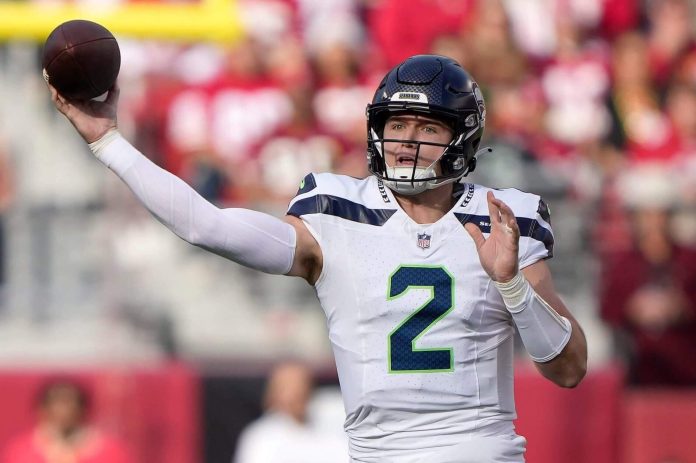[ad_1]
The dust has mostly settled on the New York Giants’ roster-building this offseason, so now is a good time to review their salary cap situation and some trends in the contracts they’ve handed out:
Cap space remaining
The Giants have $6 million in cap space, according to the NFLPA. That doesn’t include their draft class, which will account for roughly $6 million on the cap.
Obviously, the Giants will need to create more cap space to get through the season. One source of cap relief would be a resolution on tight end Darren Waller’s uncertain fate.
If Waller retires (or is released) before June 1, the Giants would create $6.7 million in cap savings while eating $7.4 million in dead money. If Waller retires after June 1, the Giants would create $11.6 million in cap savings while eating $2.5 million in dead money this year and $4.9 million in dead money in 2025.
Waller is genuinely undecided about his future and indicated a decision may not come until the summer. If he does retire after June 1, the $11.6 million in cap savings would likely allow the Giants to avoid making any other moves to create operating space.
If Waller returns, general manager Joe Schoen will need to restructure other contracts. The most obvious restructure candidates are left tackle Andrew Thomas (up to $10.4 million in cap savings), outside linebacker Brian Burns (up to $5.5 million in cap savings), linebacker Bobby Okereke (up to $4.5 million in cap savings) and defensive tackle Dexter Lawrence (up to $3.7 million in cap savings).
Of course, the biggest savings would come from restructuring quarterback Daniel Jones’ contract (up to $22.9 million), but that’s highly unlikely since that would push more dead money into the future when the team may be looking to move on.

GO DEEPER
Giants offseason winners and losers: How fortune favored Daniel Jones
Schoen could restructure those deals to pursue an expensive free agent or two even if he gets cap relief from a Waller retirement. But that wouldn’t be consistent with the patient approach Schoen has preached this offseason.
Two other potential moves that would create cap space: Trading wide receiver Darius Slayton and cutting cornerback Nick McCloud’s pay.
Slayton, who has been skipping the voluntary offseason program because he wants more money, expressed optimism two weeks ago that a resolution would be reached soon. But if the sides can’t find a common ground, the Giants could trade Slayton, which would create $4 million in cap savings.
McCloud signed a one-year, $3 million restricted free agent tender this offseason. The catch is the RFA tender comes with no guaranteed money, so the Giants could squeeze McCloud for a pay cut before the season if he hasn’t secured a prominent role. Schoen has extracted pay cuts from Slayton and cornerback Darnay Holmes to the minimum salary in the past two offseasons. A similar squeeze on McCloud before cut day this year could yield $1.9 million in cap savings.

GO DEEPER
Giants GM Joe Schoen preaching patience. Why that’s going to be a tough sell
Locked up
Typically, when contracts first get reported, the overall value is inflated. Agents want to broadcast the maximum value of a contract, so sometimes the true value isn’t known until any incentives or bonuses are reported.
The reporting of Drew Lock’s contract with the Giants was the opposite. National insiders reported Lock had signed a fully guaranteed one-year, $5 million contract in March.
The $3 million Lock can earn via incentives wasn’t reported at the time. That was interesting since the deal could have been accurately reported as being worth “up to” $8 million. It was a curious omission from the initial reports, especially on the heels of Seahawks general manager John Schneider’s comments that the Giants “basically sold (Lock) on the opportunity to compete to be the starter.”
The Giants pushed back strongly against Schneider’s account, with Lock saying it had been conveyed to him that “Daniel Jones is the starter on this team.” But the incentives certainly will make it more lucrative for Lock if he becomes the starter.
The incentives are based on playing time, individual performance and team success.
There’s up to $1 million for playing time: $250,000 for playing 40 to 49 percent of the snaps this season; another $250,000 for 50 to 59 percent, another $250,000 for 60 to 69 percent; and another $250,000 for 70 percent or more.
There’s up to $1 million for performance (all with a minimum of 224 pass attempts): $250,000 for a 92.5 passer rating; $250,000 for a 65 percent completion percentage; $250,000 for 15 touchdown passes and an 88 passer rating; and $250,000 for 2,000 yards passing and an 88 passer rating.
There’s up to $1 million for playing time and team performance: $500,000 for 55 to 69 percent of the snaps and a playoff berth; another $500,000 for 70 percent or more of the snaps and a playoff berth.
Interestingly, Lock’s incentives package mirrors the one Tyrod Taylor had in the two-year, $12 million contract he signed with the Giants in 2022. At the time of Taylor’s signing, it was viewed as a possibility he could be a bridge starter in his second season if the Giants moved on from Jones after 2022.
Though it’s unusual that the max value wasn’t initially reported, Lock’s contract doesn’t indicate anything definitive about his role. Taylor signed a two-year, $12 million contract with the same $3 million annual incentives package to back up Aaron Rodgers with the Jets this offseason.
Jacoby Brissett signed a one-year, $8 million contract to serve as the Patriots’ bridge to No. 3 pick Drake Maye. Marcus Mariota signed a one-year, $6 million contract to serve as a bridge/backup to Commanders’ No. 3 pick Jayden Daniels. Brissett and Mariota each can earn up to $4 million in incentives based on playing time and team success.

GO DEEPER
Meet the Giants UDFAs: An Irish kicker, a competitive ‘freak’ and the next Tommy DeVito?
Singled out
The Giants made a more economical investment at running back this offseason, signing Devin Singletary to a three-year, $16.5 million contract while Saquon Barkley departed for a three-year, $37.8 million contract from the Eagles.
Singletary’s contract includes up to $1 million in incentives based on playing time and performance.
There’s up to $625,000 for performance: $125,000 for 1,100 total yards (rushing and receiving); another $250,000 for 1,200 total yards; another $250,000 for 1,300 total yards.
There’s up to $375,000 for playing time: $125,000 for playing 56 to 65 percent of the snaps; another $250,000 for playing 66 percent or more.
That incentive package emphasizes what a weak concession Barkley got from the Giants last summer after the sides failed to agree on a long-term deal. With Barkley forced to play on the $10.1 million franchise tag, the Giants gave him $909,000 in incentives to entice him to show up for training camp.
Barkley could have earned $303,000 for 11 total touchdowns; another $303,000 for 65 catches; another $303,000 for 1,350 yards. The Giants also needed to make the playoffs for any of those incentives to be earned.
Compare that to Singletary being in line to earn $1 million if he plays 66 percent of the snaps and gains 1,300 yards from scrimmage regardless of how the team fares.
Contract construction
Some aspects of contracts under Schoen have been consistent throughout his tenure. He’s a major proponent of workout bonuses, which incentivize participation in the offseason program, with even some minimum contracts including bonuses in the $25,000 to $50,000 range. Schoen also prefers a “flatter” structure for significant deals with salaries relatively equal after the first year of the contract rather than backloaded. And, when possible, he eschews void years, which are a device to maximize cap space in the present but pushes dead money into the future.
One noticeable change this year has been an increase in the usage of one-game roster bonuses. Wide receiver Allen Robinson ($75,000), wide receiver Isaiah McKenzie ($92,500), wide receiver Miles Boykin ($20,000), tight end Chris Manhertz ($20,000), offensive lineman Matt Nelson ($67,500), offensive lineman Aaron Stinnie ($42,500) and cornerback Darnay Holmes ($50,000) will earn a bonus if they’re on the active roster for one game this season.
Schoen had sprinkled that type of bonus into a few minimum contracts in his first two offseasons, but it became more prominent this year. All seven players with the one-game roster bonus in their contract were signed to veteran salary benefit deals. VSBs are one-year minimum salary contracts for veterans that count against the cap at the same rate as a minimum contract for a second-year player ($985,000).
VSBs are allowed to have a maximum of $167,5000 in additional compensation. The one-game roster bonuses count toward that additional compensation. Rather than guaranteeing the full $167,5000 in a signing bonus, the Giants are making some of that money only attainable if the player makes the roster.
Robinson got a VSB deal with just $25,000 guaranteed. That’s an indication of how much the 31-year-old’s value has fallen since he posted consecutive 1,000-yard seasons in 2019 and 2020.

Free, daily NFL updates direct to your inbox. Sign up
Free, daily NFL updates direct to your inbox. Sign up
(Photo: Thearon W. Henderson / Getty Images)
[ad_2]
Source link


